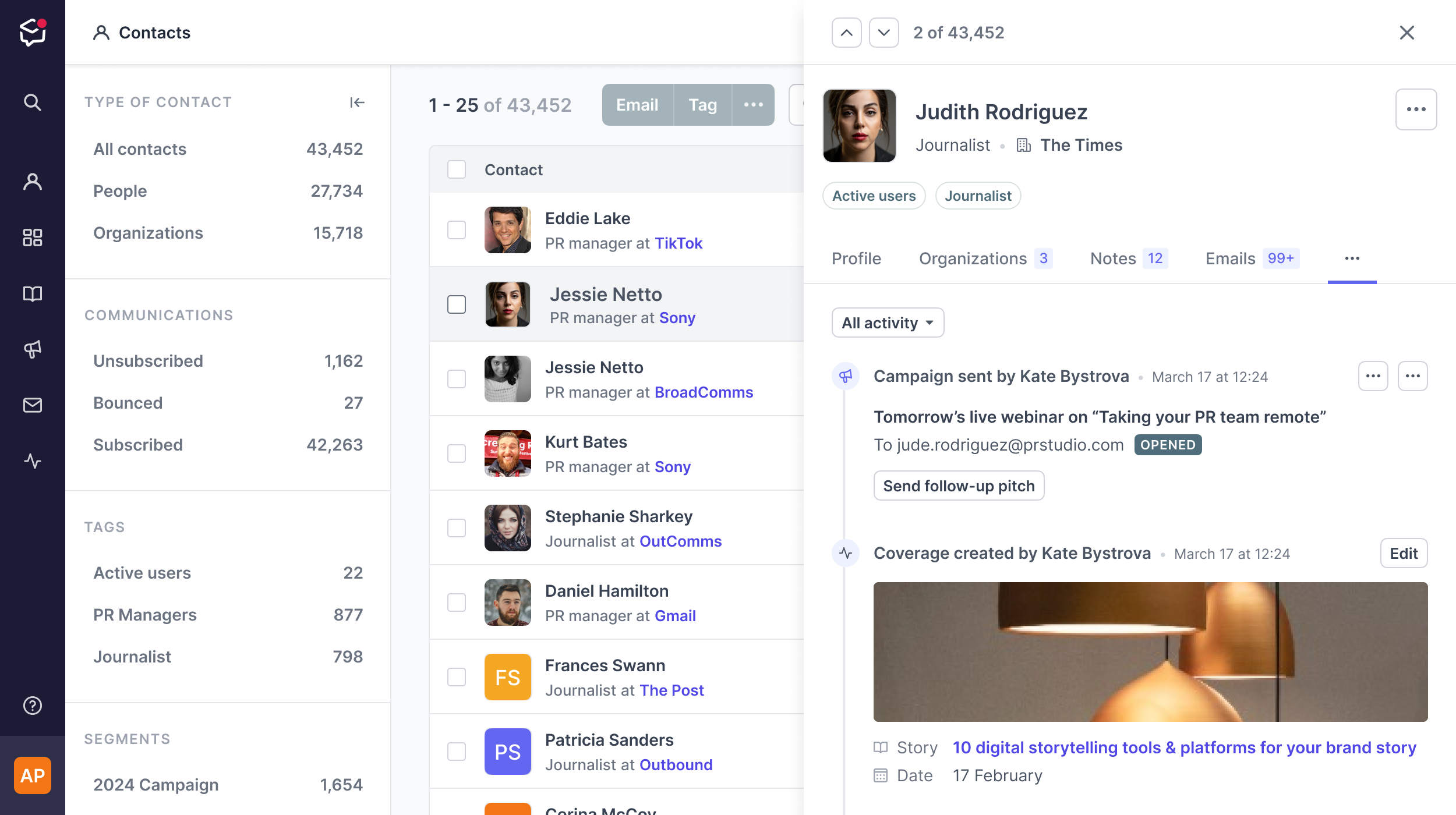How to Pitch Journalists (And Earn Media Coverage) in 2025
Journalists get hundreds of pitches. Here's how yours can actually get read.
You’ve got a great story. Maybe it’s a product launch, a milestone you’re proud of, or a mission-driven service the world should know about. You send a pitch to a particular journalist, cross your fingers, and wait.
Then, crickets.
This is a common experience for PR folks, startup founders, and small business owners trying to get media coverage. Journalists are drowning in pitches every day, and most of those emails get ignored. Not because the stories aren’t good, but because the pitches aren’t.
The truth is, most journalists want interesting stories and they rely on pitches to find them. As a PR pro, your job is to make your pitch stand out, make their job easier, and build relationships that go beyond a one-off email.
This guide will walk you through how to pitch to journalists the right way. We’ll cover what a good pitch looks like, how to avoid classic mistakes, when to pitch for the best impact, and how public relations tools like Prezly can help you manage it all with less guesswork.

Use this free PR library to find the perfect email template for your next PR or media pitch. Simply copy and paste it, personalize, and hit send.
A media pitch is a short, personalized message sent to a journalist to persuade them to cover your story. Unlike a press release, which contains all the details, a pitch is a teaser – it highlights the most newsworthy angle and explains why it matters to that journalist’s target audience.
Think of it as a movie trailer, not the full script.
Types of pitches include:
- A short email pitch introducing a timely news story
- A personal note offering an interview with your founder or spokesperson
- A suggestion for a feature tied to a trend or current event
The goal is to start a conversation, not dump your entire company history into an email.
Media pitch | Press release |
|---|---|
Sent directly to relevant journalists | Usually distributed widely |
Short, personalized message | Full-length announcement |
Tailored to each outlet | Same message sent to many |
Meant to spark interest | Meant to inform |
A pitch gets attention. A press release gives details. You might link to a press release in your pitch, but never copy-paste the whole thing.
Think of the pitch as the invitation and the press release as the party.
Why does this distinction matter? Because most journalists don’t have time to read massive emails. They want a hook, a headline, and a clear reason to care – fast.
Pitching to journalists is the act of reaching out with a story idea and persuading them to cover it. That’s it at its core. It’s a critical part of media outreach and helps bridge the gap between your brand and public visibility.
You’re not just sending information, you’re trying to spark interest in a meaningful way.
There are different types of PR pitches:
- A short email introducing a timely news story
- A personal note offering an interview with your founder or spokesperson
- A suggestion for a feature tied to a trend or current event
The goal is to start a conversation, not dump everything you’ve ever done into an email and hope something sticks.
Create and send personalized PR email pitches with Prezly. Embed your press releases. Used by leading teams to send 80,000+ pitches last year.
Before you can pitch a journalist, you need to find them. Here are practical ways to find and reach out to journalists:
- Media databases: These offer fast access to media contacts, but they can be expensive and may have outdated or broad information
- LinkedIn: Search for journalists by title or publication, and find contact details on their profiles
- Google News bylines: Find recent stories on your topic and check bylines for journalist contact info
- Substack: Look for newsletters from freelance journalists and use the provided contact info
- Email discovery tools: Use tools like Hunter.io and RocketReach to find journalists' email addresses
- Social media: Many journalists share contact details on Twitter, LinkedIn, or Instagram
- Verify email addresses: Tools like Prezly, NeverBounce, and Hunter Email Verifier help confirm if an email is valid, reducing bounces
Learn more about how to find journalist contact information ->
Every successful pitch shares a few key elements. Let’s break them down.
If you’re sending out mass emails with generic intros, you’re not pitching. You’re spamming. If your pitch starts with “Dear journalist”, expect the trash folder.
Personalization is non-negotiable. Journalists can spot a copy-paste job from a mile away, and it’s one of the fastest ways to get ignored.
So what does personalization actually look like?
- Mention the journalist’s recent work: “I loved your piece on microplastics in packaging. Our team just launched a product that tackles that exact issue in a new way.”
- Reference their beat: “I saw you often cover sustainable design. Our story might fit well with your audience.”
- Acknowledge timing or relevance: “With the holiday season coming up, we thought this angle might be a fit for your gift guide.”
This kind of personalized pitch makes it easier to capture attention from the right journalists.
This doesn’t mean you have to write 100% original emails from scratch. You can use tools like Prezly to personalize at scale, customizing intros while maintaining consistent messaging elsewhere.
But in general, your PR pitches should have a decent level of humanness and not sound like it was copied-and-pasted straight from your favorite chatbot.
Tip: It's worth mentioning that niche publications are often more likely to pick up your story than a national outlet, especially if you're just starting out.
Journalists get a lot of emails. They don’t want to read a manifesto.
Keep your pitch under 200 words if possible. Use short paragraphs. Stick to the point.
A simple framework:
- Subject line: Clear, specific, and attention-grabbing
- Opening line: Why you’re reaching out
- The story: What’s new, relevant information, or exciting brand story relevant to your contact's target audience
- Call to action: What you want them to do next (interview? coverage? reply?)
- Link: Press release, online newsroom, images, or background info
No jargon. No filler. No need to wax needlessly poetic. Just a clear, compelling reason to care – something that speaks directly to the journalist's readers.
This line determines whether your email gets opened or ignored. Avoid clickbait. Focus on clarity and brevity, keeping in mind the ideal headline length is much shorter than you might think.
What works (for example):
- “Study: Gen Z freelancers more likely to use AI than any other group”
- “Pitch: Interview with the founder of a zero-waste packaging startup”
- “New app helps parents manage screen time, backed by clinical research”
What doesn’t:
- Press release from our company
- “Exciting opportunity for media coverage”
- “Please consider this story”
Specific beats vague, every time.
Effective PR pitches start with a subject line that delivers clarity, not confusion.
A good pitch isn’t about your company. It’s about the story you’re offering.
So before you pitch, ask: Who is this for? Why should readers care? How is this different from what’s already out there?
Example: Launching a meditation app isn’t news. But launching a meditation app designed for neurodivergent teens, backed by therapists and supported by research? That’s an angle.
Tie your story to trends, news cycles, or common pain points. A unique angle that addresses your target audience’s interests is more likely to get picked up.
Make the journalist think, “I haven’t seen this before. I can make a story out of this and pitch it to my editors.”

With your business, not with each other. That would be creepy.
Even the best pitch will flop if it lands at the wrong time.
Generally:
- Avoid Mondays (inboxes are chaos and you don’t want to be competing with everyone and their mother)
- Midweek mornings are best (Tuesday–Thursday, 9–11 am)
- Steer clear of Friday afternoons and holidays.
But think beyond the clock:
- Tie PR pitches to major events, seasons, or trends
- Offer embargoed stories ahead of time so journalists can prep
- Use awareness days (mental health, women in tech, Earth Day) to your advantage, if relevant
Meeting deadlines is key – pitching too late can mean missing your shot entirely.
Let’s talk about the stuff that kills PR pitches before they even get read.
You send the same pitch to 100 journalists. You get zero replies. That’s not bad luck, it’s bad targeting.
Not every story is relevant to every outlet. Do your homework and find the right person to reach out to. Build segmented media lists. Tailor your message. You can still work efficiently with the help of PR tools, but the scattergun approach is never the answer. Unless, of course, the question is, “how can I pitch badly?”
Reaching out to multiple people with the same generic message makes it virtually impossible to build trust or get results.
Dumping everything you know into an email doesn’t make you look thorough. It makes you look clueless about what journalists actually need.
Stick to the essentials. Use bullets to highlight key facts. Link out to the press release, not the whole PDF as an attachment. Nobody wants 1,000 words and five logos in an unsolicited email.
Sending one pitch and never following up is a missed opportunity. But being overly aggressive can backfire just as fast.
The sweet spot:
- Wait three to five days after your initial email
- Send one short, friendly follow-up
- Don’t follow up more than twice unless they reply
A follow-up can be as simple as:
Hi [Name], just flagging this in case it got buried. Let me know if you’d like more info or images!
Even PR professionals can sometimes overdo it. But a good follow-up email can mean the difference between coverage and the spam folder.
Some journalists prefer bullet points. Some prefer formal PR pitches. Others want you to slide into their DMs with a good hook.
Check their bio, past stories, or social profiles. If a journalist says, “Please don’t send attachments,” don’t send attachments. Respecting their preferences shows you’re paying attention, and that earns points.
Knowing their preferred method of communication helps you pitch easy and stay out of trouble.
But remember to not be weird. Don’t go stalking them and their whole family just to personalize your messaging (you might be surprised how often this happens).
.jpg)
Tired of getting no love from your media contacts? We got you.
You’ve got your pitch. But when you send it is just as important as what you send.
While every beat is different, these general guidelines hold up:
- Midweek mornings: Most journos check email early, and mid-morning is a good balance of time and journalist attention
- Avoid Mondays and Fridays: Mondays are hectic, and Fridays are for clearing inboxes
- Consider time zones: Local news = local time. If you’re pitching US-based media, don’t send at 5 pm London time
But also pitch with purpose. Are you launching a product during a relevant event? Pitch ahead of time. Do you have insight on a breaking news topic? Reach out fast, with clear value. Trying to land gift guide coverage? Start at least two months in advance.
Media relations is about timing as much as storytelling.
You may not know the journalists’ media calendar and that’s okay, but do your best to consider how much time they’ll actually need to run your story and plan accordingly.
Every pitch should fit into a bigger picture. Ask yourself:
- What’s our goal here?
- How does this story support our brand narrative?
- Who are we trying to reach?
Build a media calendar. Think long term. That way, your media outreach is part of a strategy, not just a panic email sent at 11 pm the night before launch.
Pitching doesn’t have to be chaotic. With the right tools, you can manage your media outreach with less stress and better results.
Prezly is one of those tools. It’s built for PR people who want to spend less time managing spreadsheets and more time telling great stories.
Here’s what you can do with Prezly:
- Build dynamic media lists: Tag journalists by beat, location, past coverage, or engagement level
- Send multimedia PR pitches: Embed images, videos, quotes, and links without bulky attachments
- Track email performance: See who opened, clicked, or replied, so you know what’s working
- Collaborate easily: Work with team members or agencies in one shared platform
- Host a branded newsroom: Centralize your press releases, company info, and media assets
Instead of guessing whether your pitch landed, you get data. Instead of copy-pasting into Gmail, you get clean, trackable outreach.
You can try Prezly free to see if it fits your workflow. No strings. Just smarter pitching.
Even a small pr agency or solo pr firm can look polished and professional with the right setup.
Try Prezly for free todaySubject: Interview: Female founder tackling plastic waste with algae-based packaging
Email body: Hi [Name],
Saw your recent piece on sustainable retail packaging – loved the insights from Nestlé. Just wanted to flag a story I thought might interest you: our founder just launched a zero-waste packaging startup using algae. It’s already being trialed by a major grocer.
Would love to connect for a short interview if you’re interested. Full press release and product images here [link to your online newsroom].
Best,
[Your Name]

Most media pitches are really bad. Let's make them better.
If you take nothing else from this article, remember this:
- Personalization gets you noticed. Know who you’re pitching and why
- Clarity and brevity are your friends. Say what matters, fast
- Timing affects outcomes. Pitch smart, not randomly
- Avoid the common traps: no mass emails, no walls of text, no spamming
- Use the right tools to make pitching journalists less painful and more effective
Pitching is both art and strategy. When done well, it doesn’t just earn coverage, it builds relationships. And those relationships open doors long after the pitch is sent.
Start your 14-day free trial of Prezly and see how much smoother your next campaign can be.
Try Prezly for free todayReady to start growing your media reach?
With Prezly you can publish press releases online, and share them directly with journalists. 14-day free trial, no credit card required.

